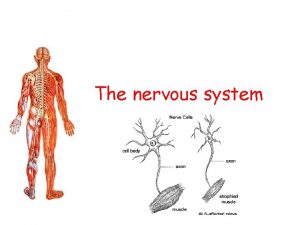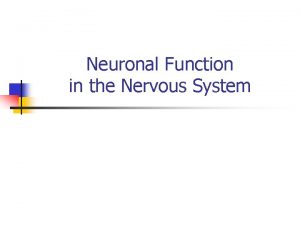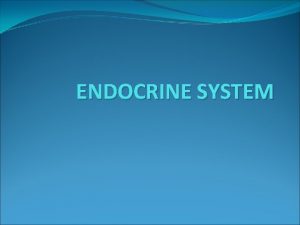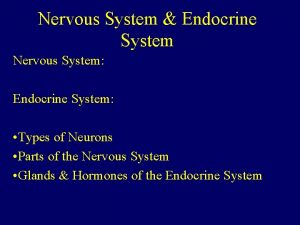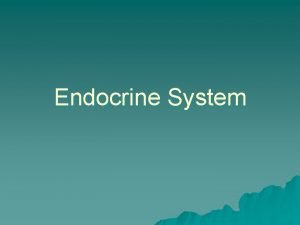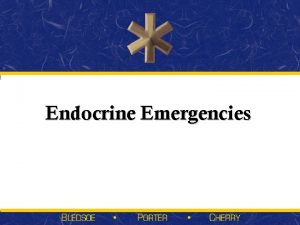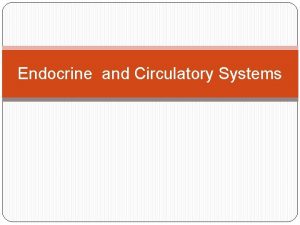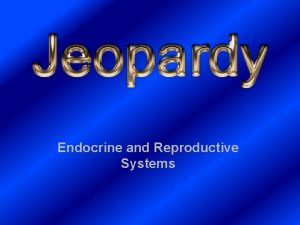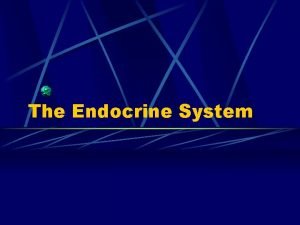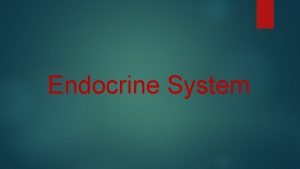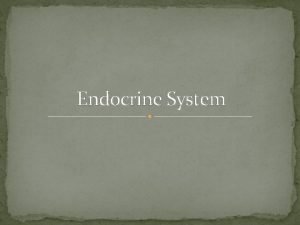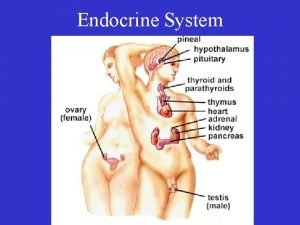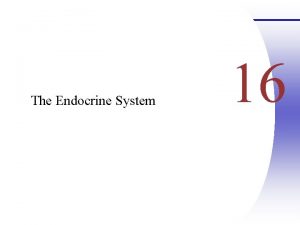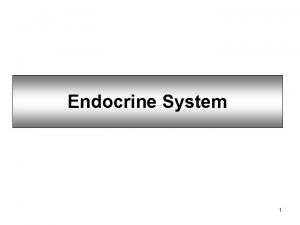Learning Targets Module 10 The Nervous and Endocrine






























- Slides: 30


Learning Targets Module 10 The Nervous and Endocrine Systems 10 -1 Describe the functions of the nervous system’s main divisions, and identify the three main types of neurons. 10 -2 Describe the nature and functions of the endocrine system and its interaction with the nervous system.

What is the nervous system? the body’s speedy, electrochemical communication network, consisting of all the nerve cells of the peripheral and central nervous systems

What are nerves? bundled axons of many neurons that form neural cables connecting the central nervous system with muscles, glands, and sense organs. For example, the optic nerve bundles a million axons into a single cable carrying the messages from the eye to the brain

What are three types of neurons? There are three types of neurons: sensory (afferent), motor(efferent) and interneurons.

How are sensory and motor neurons different? sensory neurons motor neurons contain afferent nerve fibers contain efferent neurons carry information from the sense organs to the CNS carry messages from the CNS to the muscles and glands

How is the nervous system divided?

Your turn! Work with a partner to correctly label the divisions of the nervous system.

What is the Central Nervous System (CNS) and what does it do? The CNS is made up of the brain and spinal cord. The CNS is the decision maker… it is responsible for coordinating incoming sensory messages and outgoing motor messages.

What is the Peripheral Nervous System (PNS) and what does it do? The PNS is made up of sensory and motor neurons. The PNS connects the body to the CNS by gathering information from the senses and transmitting messages from the CNS.

What are the two parts of the peripheral nervous system? somatic controls the body’s skeletal muscles also called the skeletal nervous system autonomic controls the glands and the muscles of the internal organs (such as the heart) operates automatically

1. What Would You Answer? Which division of the peripheral nervous system enables a person to move the muscles necessary to walk down the street? A. central nervous system B. sympathetic C. parasympathetic D. somatic E. endocrine

How is the autonomic division further broken down? sympathetic nervous system parasympathetic nervous system arouses the body, mobilizing its energy calms the body, conserving its energy fight, flight or freeze rest or digest The gas pedal of a car. The brake pedal of a car.

The sympathetic nervous system… accelerates heartbeat, raise blood pressure, slows digestion, raises blood sugar, and cools the body

The parasympathetic nervous system… decelerates heartbeat, lowers blood pressure, stimulates digestion, processes waste, and calms the body

AP® Exam Tip Understanding the physiological effects of stimulation by the sympathetic and parasympathetic divisions is often assessed on the AP® exam. Pay close attention to the diagram in the previous slide and spend time learning the mechanisms that are stimulated or depressed during activation.

2. What Would You Answer? Which division of the autonomic nervous system calms a person down once a stressful event has passed? A. parasympathetic B. central C. somatic D. sympathetic E. endocrine

How do the two parts of the central nervous system function? brain spinal cord Comprised of the cortex and subcortical structures carrying out various functions 2 -way connection between PNS and brain Nerves arranged into neural networks Like people grouping in cities Oversees the sensory and motor pathways of reflexes.

How does a reflex occur? 1 Sense receptors in the skin send signals up through the spinal cord via sensory (afferent) neurons. 2 Interneurons in the spinal cord receive the information from the sensory neurons and send signals back through motor neurons. 3 Motor (efferent) neurons connect to muscles in the body and direct movement.

How does a simple reflex occur? A simple reflex. . . like that to pain… occurs only in the spinal cord before information reaches the brain.

What is the endocrine system? the body’s “slow” chemical communication system; a set of glands that secrete hormones into the bloodstream

What is the difference between the nervous system and the endocrine system? nervous system endocrine system § Neurons release neurotransmitters § Glands secrete hormones § Neurotransmitters move across synapses § Hormones move through the bloodstream § Neural transmission is nano-fast § Hormonal secretion is slower § “text message” § “email”

3. What Would You Answer? Hormones are _____ released into the bloodstream. A. B. C. D. neurons myelin action potentials electrical messengers E. chemical messengers

What are the glands of the endocrine system?

What are the adrenal glands? When the sympathetic nervous system is activated (during a fight, flight, or freeze event), the adrenal glands release epinephrine and norepinephrine (adrenaline and noradrenaline) to energize the body.

Fun fact! Norepinephrine (noradrenaline) is both a hormone and a neurotransmitter. Epinephrine (adrenaline) energizes the body, but norepinephrine (noradrenaline) is released in the PNS to calm the body.

What is the pituitary gland? The pituitary gland is the endocrine system’s most influential gland. The hypothalamus directs the pituitary gland to regulate growth and control other endocrine glands. The hypothalamus is part of both the CNS and the endocrine system.

The pituitary gland its secretions. growth hormone: regulates growth and metabolism Oxytocin: stimulates the uterine contractions of childbirth and milk secretion during breastfeeding; also promotes pair bonding, group cohesion and trust. Pituitary gland secretions direct other endocrine glands to secrete their hormones.

Learning Target 10 -1 Review Describe the functions of the nervous system’s main divisions, and identify the three main types of neurons § § CNS is the brain and spinal cord PNS is divided into the somatic and autonomic systems the sympathetic and parasympathetic are the divisions of the PNS Three types of neurons: sensory, motor and interneurons

Learning Target 10 -2 Review Describe the nature and functions of the endocrine system and its interaction with the nervous system. § § § The endocrine system secretes hormones into the bloodstream The adrenal glands release hormones that trigger the fight, flight or freeze response The pituitary is the master gland is influenced by the hypothalamus
 Differences between nervous system and endocrine
Differences between nervous system and endocrine Comparison of endocrine and nervous system
Comparison of endocrine and nervous system Are endocrine glands ductless
Are endocrine glands ductless Endocrine system
Endocrine system Endocrine system vs nervous system
Endocrine system vs nervous system Endocrine vs nervous system venn diagram
Endocrine vs nervous system venn diagram What are the characteristics of nervous tissue
What are the characteristics of nervous tissue Fundamentals of the nervous system and nervous tissue
Fundamentals of the nervous system and nervous tissue Processes of nerve cell
Processes of nerve cell Writing learning targets
Writing learning targets Agonist antagonist muscles
Agonist antagonist muscles Druggist fold definition
Druggist fold definition Knowledge targets examples
Knowledge targets examples Learning targets knowledge, reasoning, skill product
Learning targets knowledge, reasoning, skill product Learning targets helping students aim for understanding
Learning targets helping students aim for understanding Objectives of warehouse management system
Objectives of warehouse management system Identifying market segments and targets chapter 9
Identifying market segments and targets chapter 9 Identifying market segments and targets chapter 9
Identifying market segments and targets chapter 9 Identifying market segments and targets chapter 9
Identifying market segments and targets chapter 9 Identifying market segments and targets
Identifying market segments and targets Segment by segment invasion
Segment by segment invasion Parathyroid gland chief cell
Parathyroid gland chief cell Alohahsap
Alohahsap Prizm segmentation scheme
Prizm segmentation scheme Cuadro comparativo entre e-learning b-learning y m-learning
Cuadro comparativo entre e-learning b-learning y m-learning Nervous system learning objectives
Nervous system learning objectives Learning objectives of nervous system
Learning objectives of nervous system C device module module 1
C device module module 1 Racial etiquette region
Racial etiquette region Brides magazine targets consumers who are in
Brides magazine targets consumers who are in Targets of change
Targets of change

























